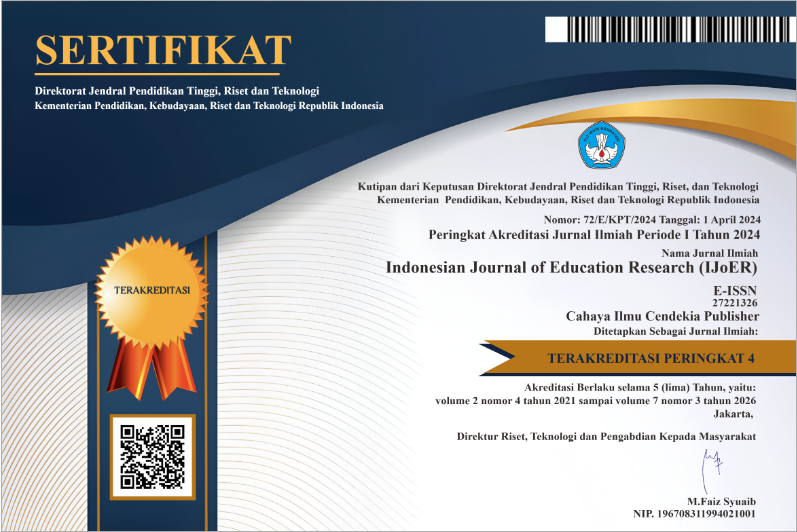Analysis of Development of Biology Teacher Performance Assessment to Assess Students in Practicum Activities
Abstract
Purpose of the study: This study aims to analyze the development of biology teacher performance assessments to assess students who are in practicum activities at SMA Negeri Batanghari Regency.
Methodology: This research is included in the quantitative descriptive research. The subjects in this study were biology teachers in class X and XI IPA at SMA Negeri 1 and 2 Batanghari Regency. The analysis carried out by the researcher included: performance task indicators, performance rubrics, and assessment methods. The research data was obtained from the results of observation sheets, self-assessment questionnaires and peer assessment questionnaires, as well as documentation.
Main Findings: Based on research on the analysis of the development of biology teacher performance assessments to assess students in practicum activities at SMA Negeri Batanghari Regency, the overall percentage results obtained were in a good category for SMA Negeri 1 (69.5%) and in a bad category for SMA Negeri 2 (48.4 %). Based on the overall results, it can be concluded that the biology teachers at SMA Negeri 1 and 2 have made performance assessments in practicum activities, but the performance assessments that have been made are incomplete. This is because the biology teacher still has not made clear performance assignments for each practicum activity to be carried out. In addition, the teacher in making rubrics did not include clear scoring.
Novelty/Originality of this study: It is expected that Biology teachers need to understand the importance of performance assessment in practicum activities by participating in training or seminars in order to achieve competence and goals in accordance with the educational curriculum.
References
S. Rakhmawati, N. Muspiroh, and N. Azmi, “Analisis Pelaksanaan Kurikulum 2013 Ditinjau dari Standar Proses dalam Pembelajaran Biologi Kelas X di SMA Negeri 1 Krangkeng,” Sci. Educ. J. Sains dan Pendidik. Sains, vol. 5, no. 2, pp. 156–164, 2016.
S. Saharuddin and M. Wahab, “Analisis Kesulitan Dalam Pemebelajaran Ipa Di Smp Negeri Limboro,” J. IPA Terpadu, vol. 2, no. 2, pp. 75–83, 2019, doi: 10.35580/ipaterpadu.v2i2.11148.
Wahyudi, “Assesment Pembelajaran Berbasis Portofolio di Sekolah,” J. Visi Ilmu Pendidik., vol. 2, no. 1, pp. 288–297, 2012, doi: 10.26418/jvip.v2i1.370.
I. Susanti, “Analisis Sikap Dan Minat Siswa terhadap Pembelajaran Fisika di SMA,” SchrödingerJournal Phys. Educ., vol. 1, no. 4, pp. 117–120, 2020, doi: 10.37251/sjpe.v1i4.447.
Kunandar, “Penilian Autentik (Penilaian Hasil Belajar Peserta Didik Berdasarkan Kurikulum 2013),” Jakarta. PT. Rajagrafindo Persada, 2014.
M. Z. Fanani, “Strategi Pengembangan Soal Hots Pada Kurikulum 2013,” Edudeena, vol. 2, no. 1, pp. 57–76, 2018, doi: 10.30762/ed.v2i1.582.
A. Rahayu and D. D. Romadona, “Deskripsi Implikasi Sosial dari Fisika , Sikap Terhadap Penyelidikan dalam Fisika dan Adopsi dari Sikap Ilmiah,” SchrödingerJournal Phys. Educ. (SJPE, vol. 1, no. 1, pp. 13–17, 2020.
Sugiyono, Metode Penelitian dan Pengembangan. Bandung: Alfabeta, 2015.
Muslich, M, “ Authentic Assessment: Penilaian Berbasis Kelas dan Kompetensi,” Bandung: PT. Refika Aditama, 2011.
Copyright (c) 2023 Amnayroh Amnayroh, Novi Indah Suryati

This work is licensed under a Creative Commons Attribution-NonCommercial 4.0 International License.
Authors who publish with this journal agree to the following terms:
- Authors retain copyright and acknowledge that the Indonesian Journal of Education Research (IJoER) is the first publisher licensed under a Creative Commons Attribution 4.0 International License.
- Authors are able to enter into separate, additional contractual arrangements for the non-exclusive distribution of the journal's published version of the work (e.g., post it to an institutional repository or publish it in a book), with an acknowledgment of its initial publication in this journal.
- Authors are permitted and encouraged to post their work online (e.g., in institutional repositories or on their website) prior to and during the submission process, as it can lead to productive exchanges and earlier and greater citation of published work.






.png)
.png)




















